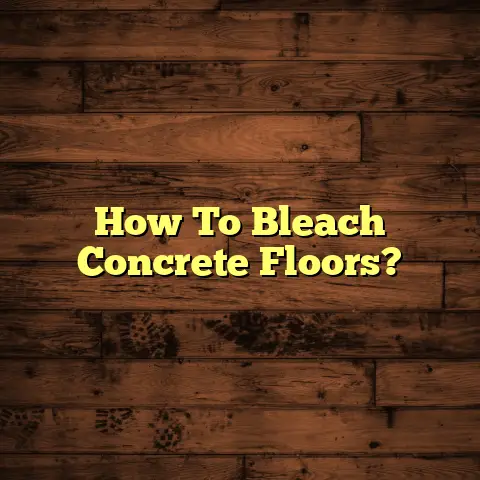How Do I Remove Scuff Marks From Hardwood Floors? (Explained)
Layering is an intriguing concept, and when it comes to flooring, it resonates deeply with my experiences as a contractor.
Just like the various layers of a cake, the surface of hardwood floors can tell a story through the layers of finish, grain, and wear.
One common problem I face is scuff marks on hardwood floors.
They might seem minor at first glance, but they can quickly accumulate and detract from the beauty of the wood.
In my years working with hardwood, I’ve learned that scuff marks can be stubborn.
I remember a project in a family home where kids played indoors constantly.
The hardwood floors were beautiful, but after just a few months, scuffs from shoes were everywhere.
I knew I had to act quickly to restore the floors’ charm.
Identifying the Scuff Marks
Before jumping into removal techniques, it’s helpful to identify what type of scuff marks you’re dealing with.
Are they from rubber-soled shoes, furniture, or perhaps pets?
Understanding the source can guide your cleaning strategy.
I once worked on a project where the previous owners had used a rubber mat at the entrance, leaving dark marks all over the floor.
The type of scuff can also determine how you approach removal.
For instance, rubber marks from shoes may require different treatments than those left by furniture movement.
Here’s a quick breakdown:
- Rubber Scuffs: Typically darker and more challenging to remove.
- Dirt and Soil Marks: These often come off with regular cleaning solutions.
- Pet Scratches: May require specialized products for removal depending on their depth.
Simple Home Remedies
Sometimes, the simplest solutions are the most effective.
Here are a few methods I’ve tried over the years:
- Baking Soda Paste: Mixing baking soda with water to form a paste has been my go-to for light scuff marks.
I apply it gently with a soft cloth and then wipe it clean.
It’s surprising how well this works!
This method is particularly useful for daily maintenance. - Vinegar and Water Solution: A mixture of equal parts vinegar and water can help lift scuff marks.
Just dampen a cloth and rub gently on the affected area.
This method not only cleans but also deodorizes the floor.
I particularly like using this when I need to freshen up the entire room. - Magic Erasers: These little sponges are fantastic for removing scuffs without damaging the finish.
I keep a pack handy for quick cleanups.
They work wonders on various surfaces beyond just hardwood. - Olive Oil and Vinegar: For a more polished approach, combining olive oil with vinegar creates a natural cleaner that adds shine while removing scuffs.
This mixture also leaves a nourishing layer on the wood.
Dealing with Stubborn Scuffs
Some scuff marks require more elbow grease.
When I encountered deep marks in a client’s home, I resorted to these methods:
- Fine Steel Wool: Using fine steel wool (0000 grade) can effectively buff out deeper scuffs without scratching the wood surface.
Apply it gently and follow up with a wood conditioner to restore luster. - Floor Scrubs: There are commercial floor scrubs specifically designed for hardwoods that can help lift stubborn marks.
I once used one on a particularly challenging job, and it worked wonders when paired with some manual scrubbing. - Refinishing: If scuff marks are persistent and widespread, refinishing might be necessary.
This involves sanding down the surface and applying a new finish.
While this process can be time-consuming, the results are often worth it.
Protecting Your Hardwood Floors
Once you’ve successfully removed scuff marks, it’s essential to protect your hardwood floors from future damage.
Here are some strategies I’ve implemented:
- Area Rugs: Placing area rugs in high-traffic areas can absorb some wear and tear.
I particularly recommend using rugs made from natural fibers for better durability. - Furniture Pads: Using felt pads under furniture legs prevents scratches and scuffing.
I’ve seen a lot of clients overlook this simple yet effective solution. - Regular Maintenance: Regular sweeping and mopping can help keep scuff marks at bay.
This routine is crucial in households with pets or children.
Cost Considerations
When it comes to cost estimation for flooring tasks, tools like FloorTally have been invaluable.
Recently, while preparing for a refinishing job, I used FloorTally to calculate material costs accurately.
It helped me determine how much sandpaper and finish I’d need while factoring in local labor rates.
This kind of detailed estimation saves time and ensures clients are well-informed about their budgets.
I’ve also found that providing clients with detailed estimates helps them understand where their money goes.
For example, during one project, I broke down the costs associated with sanding versus simply cleaning and polishing the existing finish.
Challenges and Lessons Learned
Throughout my career, I’ve faced various challenges regarding scuff mark removal.
One memorable instance was when I underestimated the impact of humidity on my refinishing job.
The finish took longer to dry than expected, leading to delays.
It taught me the importance of considering environmental factors when scheduling work.
I’ve also learned that not every method works for every floor type.
For instance, darker wood finishes may show lighter scratches more prominently than lighter woods do.
I always share this insight with clients so they know what to expect.
Another challenge I’ve encountered is dealing with different types of finishes on hardwood floors.
Some homes have an oil-based finish that requires specific cleaning agents, while others have water-based finishes that respond differently to various products.
Understanding these nuances is critical for achieving the best results.
Seasonal Considerations
One factor that often gets overlooked is how seasonal changes affect hardwood floors and their maintenance needs.
In winter, for example, salt and dirt from boots can lead to increased scuffing and scratching on floors.
During these months, I’ve developed a routine that involves:
- Entryway Mats: Placing heavy-duty mats at entrances helps reduce dirt tracked inside.
- Frequent Cleaning: Increasing the frequency of cleaning during winter helps manage salt residue and dirt.
- Humidity Control: Using humidifiers in dry months helps maintain moisture levels in wood, preventing shrinkage and cracking.
In summer, on the other hand, sun exposure can lead to fading in certain areas of hardwood floors.
I recommend using blinds or UV-blocking window films to protect against excessive sunlight.
Advanced Techniques
While basic cleaning solutions can be very effective, there are advanced techniques I’ve picked up that are worth sharing:
- Steam Cleaning: Using a steam cleaner specifically designed for hardwood floors can effectively remove stuck-on dirt and grime without damaging the finish.
However, this method requires caution; too much heat or moisture can warp the wood. - Professional Products: There are numerous professional-grade cleaning products available that target scuff marks specifically.
In one project where I managed an office renovation, we used a specialized cleaner that worked wonders on deep-set scuffs. - Sanding Techniques: For stubborn marks that resist all efforts, light sanding in the affected areas can help remove them before reapplying the finish.
This technique requires skill and should be done carefully to avoid uneven surfaces.
Comparing Different Approaches
Over the years, I’ve compared various approaches to removing scuff marks from hardwood floors:
- Home Remedies vs.
Commercial Solutions: While home remedies like vinegar and baking soda are cost-effective and safe, commercial solutions often deliver faster results for tough stains. - Manual Cleaning vs.
Machine Cleaning: Manual methods provide better control but require more effort than machine cleaners, which save time but may not always reach into crevices effectively. - DIY vs.
Professional Help: For minor issues, DIY methods work well; however, significant damage or widespread scuffs might necessitate professional intervention to ensure proper care.
Personal Anecdotes
Reflecting on my journey as a flooring contractor brings back many memories of challenging projects where scuff marks were prominent.
In one particular case, I worked on a historic home where the owners were adamant about preserving its original charm while dealing with years of wear and tear.
The solution involved carefully assessing each area of the floor for damage caused by furniture and foot traffic over decades.
I had to balance preserving the integrity of the wood while ensuring it looked beautiful again.
Using both traditional techniques and modern cleaning solutions helped restore its former glory without compromising its historical value—a learning experience that reinforced my belief in understanding both materials and methods.
Conclusion
Removing scuff marks from hardwood floors is a task that requires a mix of techniques and patience.
From simple home remedies to more intensive methods like refinishing, each approach has its merits based on the condition of your floors.
Sharing these experiences with friends or clients helps build trust and provides them with practical solutions they can use at home.
So whether you’re dealing with minor scuffs or considering a full refinishing, remember that there’s always a method that fits your situation.
If you have any tips or tricks that have worked for you, I’d love to hear about them!
Let’s chat about our experiences in keeping those beautiful hardwood floors looking their best!





